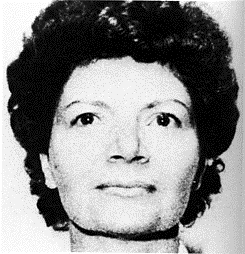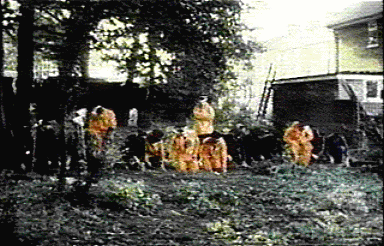

| AGE | DATE | PLACE | OUTCOME | LAST ATTACK |
|---|---|---|---|---|
| 47 | August 20 1980 Wednesday night 11:00 pm | Leeds | Murdered | 353 days |
Marguerite Walls was a forty-seven-year-old civil servant who worked at the Department of Education and Science office in Pudsey. She had worked late on Wednesday, August 20 1980, working extra hours as she was going on a ten-day holiday the following day. She left her office between 9:30 pm and 10:30 pm to walk the half mile to her home in Farsley, a suburb of Leeds. Meanwhile, Peter Sutcliffe was driving through Farsley on his way to Chapeltown when he spotted Marguerite Walls walking towards him.
Sutcliffe parked his car and proceeded to quickly catch up and overtake her over a distance of about 400 yards. Near a driveway with high stone pillars, he stunned her with a hammer blow to the back of the head, shouting "filthy prostitute" as he struck further blows to her head. He then looped a length of rope around her neck, tightening it as he half-carried, half-dragged her about 20 yards from the point of attack up the driveway and into a high-walled garden. There, while kneeling on her chest, he strangled her. After she was dead, he stripped her of all her clothing except her tights. When he left her, he partially covered the body with grass cuttings and leaves.

Marquerite Walls body was found the next day by two gardeners, her shoes found in the driveway, and her skirt, shopping bag and chequebook found near a rockery close to the garden. Detective Chief Superintendent James Hobson, after consultation with forensic experts announced: "We do not believe this is the work of the Yorkshire Ripper." While there were obvious Ripper-like elements to the attack, the use of a ligature (never used in a known Ripper attack before), and the lack of stab wounds, appeared to suggest a new, different killer.
Peter Sutcliffe's use of the length of rope to strangle Marguerite Walls had been a conscious effort to change his method of attack to mislead the police and downplay the Yorkshire Ripper police and media fervour. With the police suggesting this was a local killing, and the murder being downplayed in the Press due to it not being considered a Ripper attack, were obvious indications Sutcliffe had succeeded, and the Yorkshire Ripper was still considered in a "dormant" stage.
STATEMENTS BY PETER SUTCLIFFE (Confessions, trial testimony, conversations, etc.)
(When asked whether he was responsible for the murder of Marguerite Walls): "No, that wasn't me. You have a mystery on your hands with that one. I've only used the rope once on that girl at Headingley (Upadhya Bandara)."
(Statement to police, January 5 1981. Source: Bilton.)
"I was on my way to Leeds, with a view to killing a prostitute, when I saw that this woman was walking towards me at a distance of about sixty yards. She disappeared around a corner on my left, so I slowed down and turned into this particular road. I was already in some kind of a rage and it was just unfortunate for her that she was where she was at the time, 'cos I parked the car and got out and followed her along the road. "
"Having caught up with her over a distance of three or four hundred yards, I let her have it with a hammer, I hit her on the head, it seems as though there was a voice inside my head saying, 'Kill, kill, kill', and as I hit her I shouted, 'You filthy prostitute.'"
"There was nobody else about, but as she was on the pavement, I dragged her inside a gateway quite a few yards, in what appeared to be someone's garden. Round about this time somebody walked pass the entrance, I don't know whether they had seen me or not, because they appeared to look in.
I didn't have a knife on me this time, but I had a length of cord which I strangled her with. I removed her clothes and I was going to leave her in an obvious position for people to see, but round about this time the road outside started to be quite busy with pedestrians going back and forth. I changed my mind and covered her up with some straw instead."
(Where he placed her body): "In the far corner of the garden near a wall. I was very upset again after this time, I knew I couldn't do anything to prevent myself carrying on killing. The inner torment was unimaginable, because, as strange as it may seem, I never wanted to kill anybody at all, I just had to get rid of all the prostitutes whether I liked it or not."
(Why he denied responsibility for this attack when questioned about it on January 5 1981): "Because when I was questioned initially I knew I was in such deep water through killing through the method I normally use, that this would possibly open completely new lines of enquiry into other murders which could have been committed and which I knew I hadn't done."
"I thought that maybe it would be better to sort this out at a later date, when I had cleared up all the other matters, and having denied it first, it would have made matters worse at the time if I had changed my mind again. Nothing I would have said could have been taken seriously, this is why I'm making a true account of everything and every detail."
(About the use of a length of rope): "Because the press and the media had attached a stigma to me, I had been known for some time as the Yorkshire Ripper, which to my mind, didn't ring true at all. It was just my way of killing them, but actually I found that the method of strangulation was even more horrible and took longer."
(After using the rope again on Upadhya Bandara): "This is when I decided I couldn't kill people like this. I couldn't bear to go through with it again, as there was something deep inside preventing me."
(Statement to police, January 26 1981. Source: Bilton.)
"I was on my way to Leeds primed with weapons for the mission. She lifted her leg up, put it down and then lifted it up again. She looked like a prostitute and was walking at a snail's pace. I killed her with no doubt. The voice shouted 'Filthy prostitute'. It wasn't like my voice, it was filthy and angry. Not like me. I don't get angry. I knew it was me who had done what I had done with my own hands, and when I get into the depression this happens."
(Statement to Dr Milne, read out in court during his trial. Source: The Times.)
 
|

|

|

|
 
|
|---|